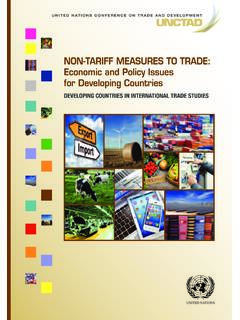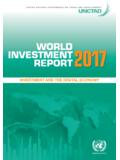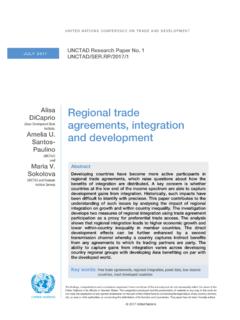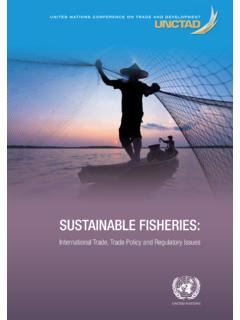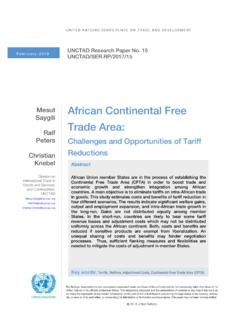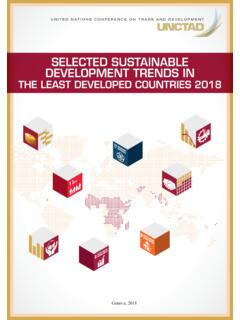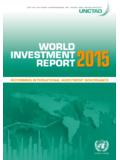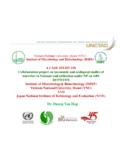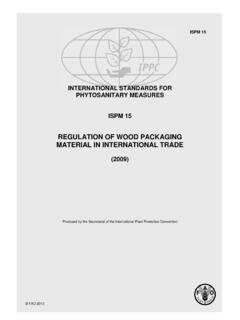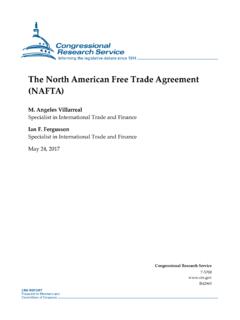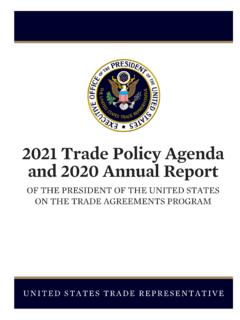Transcription of WORLD TRADE ORGANIZATION 3.5 GATT 1994 - UNCTAD
1 WORLD TRADE GATT 1994 Dispute SettlementiiN O T EThe Course on Dispute Settlement in International TRADE , Investmentand Intellectual Property consists of forty module has been prepared by Mrs. St phanie Cartier at the request of theUnited Nations Conference on TRADE and Development ( UNCTAD ). The viewsand opinions expressed in this module are those of the author and not necessarilythose of the United Nations, WTO, WIPO, ICSID, UNCITRAL or the AdvisoryCentre on WTO designations employed and the presentation of the material do not implyan expression of any opinion whatsoever on the part of the United Nationsconcerning the legal status of any country, territory, city or areas or of itsauthorities, or concerning the delimitations of its frontiers or United Nations holds copyright to this document.
2 The course is alsoavailable in electronic format on the UNCTAD website ( ).Copies may be downloaded free of charge on the understanding that they willbe used for teaching or study and not for a commercial purpose. Appropriateacknowledgement of the source is United Nations, 2003 All rights reservedUNCTAD/ GATT 1994iiiTABLE OF CONTENTSN oteiiWhat you will learn11 GATT 1994 : TRADE IN Does GATT Mean? of Application of the GATT of the GATT of the GATT Instruments Adopted under the GATT and the Marrakesh Relationship Between the GATT 1994 and Other WTO The Relationship Between the GATT 1994 and the WTO The Relationship Between the GATT 1994 and Other Agreements inAnnex 1A to the WTO Your Understanding112 THE PRINCIPLE OF NON-DISCRIMINATION IN THE GATT : Treatment Obligation: Article is There a Violation of the Most-Favoured-Nation Treatment Obligation?
3 Has an advantage been conferred upon imported or exported products? Are the products like ? Was the advantage accorded immediately and unconditionally ? Treatment Obligation: Article is There a Violation of the National Treatment Obligation,under Article III:2, first sentence? Have internal taxes been applied? Are the imported and domestic products like ? Are the imported products taxed in excess of the domestic products? is There a Violation of the National Treatment Obligation,under Article III:2, second sentence? Have internal taxes been applied ? Are the imported and domestic products directly competitive or substitutable ? Are the imported and domestic products not similarly taxed ? Is the internal tax measure applied so as to affordprotection to domestic production ? is There a Violation of the National Treatment Obligation,under Article III:4?
4 Have laws, regulations or requirements affecting the sale anduse of products been applied? Are the imported and domestic products like ? Was the treatment less favourable? Your Understanding41 Dispute Settlementiv3 THE MARKET ACCESS PRINCIPLE IN THE GATT Access Barriers: Tariff Concessions in Interpreting Tariff Onus of Clarifying Tariff Tariff Concessions and the GATT Quantitative General Prohibition of Quantitative Exceptions to the General Administration of Quantitative Duties and Financial Non-Tariff and Administration of TRADE Enforcement Only After Official Publication of Laws and , Impartial and Reasonable Administration of Laws and Your Understanding544 EXCEPTIONS TO THE DISCIPLINES IN THE GATT Are the General Exceptions to the GATT 1994 ? Types of Measures Enumerated in Article Necessary to Protect Human, Animal or Plant Life under Article XX(d) Relating to the Conservation of Exhaustible Requirements of the Chapeau of Article or Unjustifiable Restriction on International are the Security Exceptions?
5 National Security Actions Under the United Nations Charter for the Maintenance ofInternational Peace and Your Understanding745 DEVELOPING COUNTRY MEMBERS IN THE GATT TRADE and Development (Part IV of the GATT 1994 ) Your Understanding866 CASE STUDY877 FURTHER and and GATT 19941 WHAT YOU WILL LEARNThe GATT 1947 is at the very source of the current WTO system. Its basicprinciples applicable to TRADE in goods have been incorporated into other WTOagreements dealing with other areas of TRADE , such as TRADE in services andtrade in intellectual property products and, it also provided the very first disputesettlement provisions upon which the WTO dispute settlement system is the GATT 1994 is only one of the numerous WTO goods agreements, its importance in the history of the GATT/WTO is Module provides an overview of the obligations relating to TRADE in goodsin the GATT first Section of this Module defines the GATT 1994 and its constituentelements.
6 The first Section also circumscribes the scope of application of theGATT 1994 , and examines its relationship with other WTO second Section discusses the cornerstone of the entire multilateral tradingsystem, the principle of non-discrimination in the GATT 1994 , and exploresits two facets: the most-favoured-nation treatment obligation and the nationaltreatment third Section addresses the market access barriers to TRADE in goods andpresents the obligations relating to the publication and administration of fourth Section deals with the exceptions to the disciplines of the GATT1994, namely, the general exceptions, the security exceptions, and theexceptions for the purposes of applying safeguard measures, balance-of-payments restrictions, and for the purpose of carrying out regional , the Fifth Section analyses the position of developing country Membersunder the GATT GATT 1994 : TRADE IN GOODSA fter completing this Section, the reader will be able to: define the GATT 1994 and its scope of application.
7 List the constituent elements of the GATT 1994 : explain the relationship between the GATT 1994 and other Does GATT Mean?The acronym GATT stands for the General Agreement on Tariffs and TRADE .It is an agreement between States aiming at eliminating discrimination andreducing tariffs and other TRADE barriers with respect to TRADE in GATT was originally, and is still today, only concerned with TRADE ingoods, although its main principles now also apply to TRADE in services, andintellectual property rights as dealt with respectively by the General Agreementon TRADE in Services and the TRIPS Agreement. The GATT is a WTOagreement that deals exclusively with TRADE in goods, but it is not the only the agreements listed in Annex 1A to the Marrakesh AgreementEstablishing the WORLD TRADE ORGANIZATION (hereinafter the WTOA greement ) concern particular aspects or sectors of TRADE in so-called WTO goods agreements in Annex 1A to the WTO Agreement consist of 1:WTO AgreementANNEX 1 ANNEX 1A.
8 Multilateral Agreements on TRADE in GoodsGATT 1994 Agreement on AgricultureAgreement on the Application of Sanitary and phytosanitary MeasuresAgreement on Textiles and ClothingAgreement on Technical Barriers to TradeAgreement on TRADE -Related Investment MeasuresAgreement on Implementation of Article VI of the General Agreementon Tariffs and TRADE 1994 (also known as the Anti-Dumping Agreement) Agreement on Implementation of Article VII of the General Agreementon Tariffs and TRADE 1994 (also known as the Agreement on CustomsValuation)GATTT rade in GoodsThe WTO Goods Agreements1 Please refer to Module , Section Several of these agreements are dealt with in separateModules of this Settlement4 Agreement on Preshipment InspectionAgreement on Rules of OriginAgreement on Import Licensing ProceduresAgreement on Subsidies and Countervailing MeasuresAgreement on SafeguardsThe GATT was concluded in 1947 and is now referred to as the GATT GATT 1947 was last amended, last in 1965.
9 Later on, additional disciplineswere agreed to in side agreements, such as the Tokyo Round agreements,which did not amend the GATT 1947 as such, but only bound the GATTC ontracting Parties that became a party to these side The GATT1947 was terminated in 1996. However, the provisions of the GATT 1947 aswell as all legal instruments concluded under the GATT 1947 are integratedinto the GATT 1994 , subject to clarifications brought about by Understandingswhich also form integral parts of the GATT acronym GATT is sometimes confusingly used to describe a number ofdifferent things. It is sometimes referred to as the GATT disciplines , or GATT disputes , to mean the current WTO obligations or disputes relatingto TRADE in goods. However, it may also be referred to as the GATT to meanthe old multilateral trading system and/or Secretariat preceding the WTO.
10 Inthis Module, GATT only means the current obligations under the of Application of the GATT 1994 The GATT 1994 is one of the multilateral agreements annexed to the WTOA greement. It is an international treaty binding upon all WTO GATT 1994 is only concerned with TRADE in goods. The GATT 1994 aimsat further liberalizing TRADE in goods through the reduction of tariffs and othertrade barriers and eliminating EC Bananas III, the question arose whether the General Agreement onTrade in Services (hereinafter the GATS ) and the GATT 1994 were mutuallyexclusive agreements. The Appellate Body said:.. The GATS was not intended to deal with the same subject matter as theGATT 1994 . The GATS was intended to deal with a subject matter not coveredby the GATT 1994 , that is, with TRADE in services. Thus, the GATS applies tothe supply of services.
